
jdowning - 11-18-2007 at 01:18 PM
Does anyone recognise the following 14th C Arabic linear scales of measurement:
- asabi'
- asabi' madmuma
- shibr
- 'aqd.
- and if so, what units do they represent when converted to present day metric measurements?
Is there any connection between the above and the following scales and is the conversion of these to metric correct?
- isba' (Arabic) and angusht (Persian)= 2.25 cm.
- isba madmum (Arabic) and angusht mundam (Persian)=4.5cm.
- shibr (Arabic) = 27cm. (see above also)
The above are mentioned in footnotes from "Studies in Oriental Musical Instruments" by Henry George Farmer
ALAMI - 11-18-2007 at 01:35 PM
Am not sure of the exact equivalent in cm but the persian equivalents seem logical:
Isba' is a digit, the width of a finger
Isbaa madmoum should be the palm
Shibr is a span, the width of spread fingers.
These terms are still commonly used as approximative length measurments.
I am not familiar with 'aqd but I think means "knot"
jdowning - 11-18-2007 at 05:56 PM
Thanks ALAMI - I guess that there is a connection between the phonetics "asabi" and "isba'" - one plural the other singular perhaps?
According to Farmer 'aqd' is equivalent to 2.25 cm - i.e. the same as isba (or angusht) - as he states that a length of 29.25 cm as equal to 1 shibr
+ 1 'aqd.
"La metrologia non e scienza, e un incubo" (metrology is not a science, it's a nightmare)" G. de Sanctis !!
jdowning - 11-19-2007 at 09:49 AM
Unfortunately Farmer does not indicate how he arrived at the metric equivalents of the ancient measurements that he refers to. He quotes a "shibr" as
equivalent to 27 cm. Perhaps Farmer assumed that this unit was equivalent to a "foot" which when divided by 12 gives an "inch" (in the English system)
- equivalent to 2.25 cm (isba)? However, the ancient Egyptian "foot" apparently was a consistent standard throughout history and measured 300 mm. The
"digit" in this scale may have been 1/16 of the Egyptian foot measuring 1.88 cm - but I don't know for sure.
This lead me to investigate further and as result found the thesis "A History of Measures" by Livio C. Stecchini - a fascinating in depth study
running to several hundred pages. This can be downloaded from http://www.metrum.org
I doubt whether it will answer my questions about Farmer's units but it will be worth reading for its own sake and for future reference.
Peyman - 11-19-2007 at 07:43 PM
Last year I got a copy of "Kanzol-tohaf" and actually posted something about it in the forum. The book is unique since it was written in Persian
(usually manuscripts of this type were written in Arabic) and it has pictures of instruments and the way they are made. In the book the measurements
of the Oud's overall are written as 30 "Angosht" (fingers) or 3 "Dasts" (hands). The dast is also known as a "Vajab" (which could be arabic). It's the
distance between the tip of the thumb and the tip of the pinky. These measurements are still used today to quickly size up.
The book doesn't say anything about the measurements. The 2.25 seems to be a good estimate since the length of the oud would be about 67.5 cm, and if
you use (my) hand, it would be about the same.
Other measurements are: width = 15 fingers, and depth = 7.5 (the depth should be half the width the book says). This makes the instrument shallower
than the modern version. Interestingly, the oud of this time (and Farabi's time) has 5 strings and has several frets.
If you check out youtube, there is a Turkish group called bezmara. They use a reconstruction of the shahrood (the "king" oud, a very large out) and a
normal oud.
Sazi - 11-20-2007 at 02:38 AM
It's interesting to note that turning the ancient measurements into cm results in instruments of a given size, whereas the ancient measurements give
various sized instruments depending on the size of the makers hands, and I'm thinking we could all get "tailor-made" instruments perfectly
proportioned for us if we got a maker to use our own hands for the measurements...
jdowning - 11-20-2007 at 06:06 AM
Thanks - in the thread 'Question - Big Ouds, Little Ouds' I refer to a large oud converted to metric units from the original dimensions. Farmer, in
his translation of the 14th C text gives the dimensions of this oud as length = 40 asabi madmuma, width = 16 asabi madmuma, depth = 12 asabi with the
bridge located at 2 asabi from the bottom of the bowl. Farmer converts these dimensions to 180 cm, 72 cm, 27 cm and 4 1/2 cm respectively. He also
gives the length of the neck and pegbox as 29.25 cm = 1 shibr + 1 'aqd. These measurements do not make much sense to me and I was wondering if there
are errors either in the original text or in the transcription by Farmer?
What might work would be to assume that the larger units of asabi madmuma (equal to 4.5 cm according to Farmer) are in error and should be asabi
instead (2.25 cm according to Farmer). This would give an oud of about 90 cm length by 36 cm wide and which would translate into a string length of
about 90 cm - 4.5 cm = 85.5 cm. This would also almost fit with a neck length of 29.25 cm which should be about 1/3 of the string length (the depth
measurement still seems way out of proportion though). This would still be a very large oud (of fairly narrow, almond shaped profile - like some early
16th C bass lutes by makers such as Maler and Frei) but with a string length that would be practical (some 16th bass lutes had string lengths of over
90 cm). However, all of this is just speculation that would need to be checked by reference to the original document.
Ouds can still be custom made to suite players of different hand sizes (and likely are?). However, the use of a hand (or finger, thumb etc), as an
ancient unit of measure, assumes that everyone is of equal stature - with same size hands, fingers etc.
jdowning - 11-20-2007 at 06:16 AM
See also the thread "Oud or Lute" by Dr Oud in the Ouds Project Forum.
Peyman - 11-20-2007 at 07:30 AM
I know of 2 instances of ancient middle eastern instruments being recreated for modern ensembles (Bezara in Turkey and Mejnun Kerimov in Azerbaijan).
In both, they heavily depended on old paintings and carvings to make estimates of the instrument length. Sometimes, these paintings are exaggerated. I
think Sazi makes a good point about the lack of real standards and tailored instruments.
jdowning - 11-20-2007 at 10:44 AM
It would be a mistake to assume that early civilizations lacked real standards of measurement - quite the contrary. The Egyptians and Romans, for
example, didn't perform their great feats of engineering and construction by "rule of thumb" so to speak - they had very precise standards of
measurement. Just because a unit of measurement was called a finger (for example) does not mean to say that they actually used a finger for
measurement (except for the average person making a quick and very rough check in the local rural market place perhaps).
I would agree that instruments depicted in paintings are often exaggerated (more often than not) so are not a reliable source from which to try to re
create an early instrument. Artists will often work by convention or from memory or will misrepresent or omit important details like strings, frets or
numbers of pegs etc..
For comparison purposes I have superimposed a half outline of the oud described by Farmer (drawn to my speculated "corrected" dimensions noted in my
previous posting) over a sketch of a small bass lute by 16th C Laux Maler. The sketch of the lute is a recreation that I made many years ago based on
a surviving soundboard by that maker. Both outlines are to the same scale with the bridge position as a common data point. Both instruments have a
relatively long narrow 'almond shaped' body with low bridge positions. The oud also has a relatively shorter neck than the lute.

Sazi - 11-21-2007 at 02:04 PM
Thank you Peyman, I thought it may help to partly explain some of the many variations in dimensions of ouds made in times and perhaps rural places,
away from centres of learning, where tape measures, calculators and the like were not common everyday household implements.
jdowning - 11-26-2007 at 10:30 AM
For those of us who do not read Arabic, I have now had it confirmed that the unit "asabi" is the plural of "isba".
See my latest posting in "Question - Big Ouds, Little Ouds" for an update on Farmer's interpretation of the dimensions of the Ibn Al-Tahhan oud.
ALAMI - 11-26-2007 at 03:23 PM
John, I think I got something for you.
It is an arabic manuscript in the university of tokyo.
Author: Hasan Ibn Umar Ibn Ma'ruf Ibn Abd Allah Ibn Mustafa al-Shatti - (1205-1274 / 1790-1858)
Title: Bast al-raha li-tanawul al-misaha .
Source: http://ricasdb.ioc.u-tokyo.ac.jp -
The link to the full pdf: (5Mb 44 scanned manuscript pages)
http://al-mostafa.info/data/arabic/depot3/gap.php?file=m003359.pdf
It won't be easy to translate, I'll do my best later if you think it would help.
Roughly, the author is talking about 3 different systems:
Zira' (arm) = 2 shibr (spans) ; shibr = 12 isba'
Another Zira' is defined as equal to 27 isba'
then the third is called Zira' Hashemia and is used in topography and is in fact 1.3 times the first Zira'
the Zira' Hashemia = 32 isba' = 8 fists ; where a fist = 4 fingers and a finger = 6 hairs
He mentions also the carpenters' Zira' and says that it is very close to the Hashemia
Regarding the word isba', you're right the plural is asabi' but it is used in plural only when it follows numbers from 3-9 or 103-109 or 203-209
etc..
otherwise it is used in the singular form isba' (yes it is funny):
example: 27 isba' - 54 isba' - 6 asabi' - 109 asabi'
the relevant page is page3 in the manuscript (4 right in the pdf)
ALAMI - 11-26-2007 at 03:52 PM
Just a tangent note,
the below page is from a manuscript in the museum of Sfax in Tunisia, I just thought it might be of interest, the pdf is very difficult to read due to
the low quality.the author is Sheikh ?? alsafaxi and it is talking about oud making and tuning.
Anybody aware of this document ?
jdowning - 11-27-2007 at 07:45 AM
Many thanks ALAMI - what a good example of a clear document scan. I am now a bit out of my depth so will need to research a bit further before asking
more questions.
Just for my information - I imagine that madmouma is plural of madmoum but how does it translate? Does it mean "double" or something similar - to make
sense of the dimensions provided by Farmer?
I suppose if some units were reserved for early topographical measurement (or navigation perhaps) this might be the link to the metric scale - the
metre being originally defined by triangulation surveys to determine the length of the meridian arc of the earth between the equator and North Pole -
the metre being 1/10,000,000 of that distance? (Alternatively perhaps more accurate siderial measurement was used as the ancients were experts in that
science?)
For information, I have updated my previous sketch comparing the profiles of the Maler lute and the Ibn Al-Tahhan oud to reflect doubling the distance
of the bridge from the bottom of the bowl speculating that the original manuscript is in error. This gives a more satisfactory match than before in my
opinion.
Also, it should be noted that the early Arabic writers, like Al-Khindi, and the authors of the 10th C Ikwan al-Safa and the Persian work Kanz al-tuhaf
- according to Farmer's translation - gives some information about the proportional dimensions of an oud. This enables an albeit limited confirmation
of the profiles of early ouds. For example that the depth of the bowl should be half the width and the length (of the bowl) should be 1 1/2 times the
width with the neck length being 1/4 of the overall length. This latter ratio would fit the neck length proportions of the Doc's oud - sketch B in
"Question - Big Ouds, Little Ouds" - but not the other two.

ALAMI - 11-27-2007 at 10:58 AM
"madmouma" means with no space in between.
So if it is said 3 asabi' madmouma = 3 jointed fingers, touching each other.
the "Kabda" in the manuscript means fist and it equals 4 asabi' madmouma and I logically suppose that wherever a measure is mentioned in fingers as
unit it means fingers "madmouma" otherwise it doesn't make sense.
jdowning - 11-27-2007 at 03:22 PM
Farmer records that the bridge location of the Ibn al-Tahhan oud is given as 2 asabi in the original manuscript (which Farmer notes as being "odd").
As asabi units can only follow numbers from 3 to 9 (and so on) then this would seem to be confirmation that the scribe had made an error of some kind
in the original manuscript?
The current speculation is that the scribe likely meant 2 isba madmoum - equivalent to 9 cm metric?
Pretty complicated!!
Thanks ALAMI
jdowning - 3-4-2011 at 08:35 AM
What is wrong with this Oud?
The attached image is a scale drawing of an oud described by 14th C writer Ibn al-Tahhan al-Musiqi according to the translation/interpretation of the
sole surviving manuscript by Dr H.G. Farmer.
Farmer was puzzled about the low placement of the bridge (which he thought odd) but was not otherwise concerned about the size of the oud which he
described as being of "considerable dimensions" and a "real archlute". He was obviously not an oud or lute player!
It is not always clear and now impossible to determine - without access to the original manuscript - what Farmer has translated word for word from the
original and what is his interpretation of the text.
Farmer gives Arabic linear measurements as 'isba' = 2.25 cm and 'isba madmum' = 4.5 cm as well as 'shibr' = 27 cm but does not give the source for
these assumed metric equivalents. He then goes on to give the measurements of the oud in terms of 'asabi' and 'asabi madmuma' - presumably as written
in the original manuscript(?). Farmer also (strangely) gives the neck length as "= 1 shibr + 1 'aqd" giving the metric equivalent as 29.25 cm - again
without clarification - from which it might be assumed that 1 shibr = 12 isba and that the neck length is then equivalent to 13 isba.
Something is not quite right here!
More to follow.
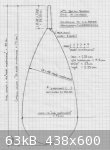
jdowning - 3-4-2011 at 11:13 AM
Note that in creating the geometry of the oud according to the dimensions given I have assumed that the lower sound board profile below the widest
point (the X axis) is a semi circle, that the upper sound board profile is described by a circular arc of radius R with its centre on the X axis, and
that the width of the neck joint is 2 isba (or 4.5 cm using Farmer's metric equivalent). R in this case works out to be exactly 48 'asabi madmuma'
units (or 96 'isba')
Curtis Bouterse, writing in The Galpin Society Journal #32, May 1979, proposes that the odd proportions of the oud are a result of scribal error - the
scribe mixing up the 'isba' and 'isba madmum' in defining the length, width and bridge placement. This gives a more reasonable result proportionally
but may not be the complete solution. Bouterse reasonably assumes that the lower sound board profile is a semi circle but makes no attempt to define a
profile for the upper sound board. He also accepts Farmer's metric conversions for the linear units as well as the 'strange' neck dimension which, if
valid, does not result in what turns out to be a more elegant solution to the final geometry (in my opinion).
Farmer assumes that 'aqd is a linear unit of measurement but what was his source? - he does not say.
ALAMI gives the meaning of 'aqd as 'knot' earlier in this thread. Several Arabic-English dictionaries give 'knot' as a definition as well as related
meanings such as ' bound' or 'tied tightly' or 'knitted together' or 'joined' or 'a binding agreement or contract'. One sole dictionary source also
includes 'inch' among these definitions.
So did Farmer or his linguist advisors know of some, now obscure, alternative definition of 'aqd - a linear measurement of value 2.25 cm or equivalent
to an 'isba' unit? There may be one possibility.
More to follow.
ALAMI - 3-5-2011 at 07:32 AM
Hey John, this oud-zilla cannot be real, we are getting something wrong!
May be when they used "asabi' madmouma" they were still counting in ones.
I mean that when they say 20 isba' madmouma they don't mean 20 X (4 fingers), they may be still mean 20 x one finger.
Another thing, the famous novel "Tom Thumb" is translated in French "Le petit poucet" and in Arabic "iqdat al isba'", literally the finger knot.
A finger knot in common spoken Arabic means the finger middle joint, what if the aqd is the upper half of the thumb? It is around 2.5 cm.
jdowning - 3-5-2011 at 08:11 AM
Thanks ALAMI. Interesting as my thumb measures pretty close to 2.3 cm at the middle joint so perhaps this is the answer to Farmer's source of unit
size?
My proposed solution follows a more complicated argument and - with no knowledge of Arabic on my part - may turn out to be completely invalid.
Nevertheless, let's go through the arguments just to see where it might lead.
OK, OK! to avoid confusion due to potential problems in interpretation/comprehension I shall now stick to the term 'finger' unit as the basic unit of
linear measurement this being the width of a finger at the middle joint (but not including the thumb). So, for example an 'isba' will be one finger
unit, an 'isba madmouma' will be 2 finger units, 8 'asabi' will be 8 finger units, 20 'isba' will be 20 finger units ... and so on.
On my hand, four fingers (madmouma) measures 7.5 cm across giving an average value of 1.875 cm for a finger unit - this value, as it happens, agrees
with the 'standard' finger unit of ancient times it would seem.
Next - all about early Arab navigators.
jdowning - 3-6-2011 at 06:25 AM
Ancient Arab and Persian Navigators
The scientists of the ancient civilisations of the Middle East were expert astronomers using their observations to develop a sophisticated analogue
computer - the astrolabe - to solve problems in spherical astronomy that was used, among other things, for precise navigation. The astrolabe had to be
held steady for readings to be taken so was difficult to use on board ship when at sea.
According to researchers studying early navigation methods, the ancient Arab seafarers used a technique known as latitude sailing in the Northern
Hemisphere. They would sail North (or South) until they reached a required latitude and then sail East (or West) maintaining this latitude until
arriving at their destination.
A latitude bearing was determined, indirectly, by estimating the angle of elevation of the Pole star above the horizon using a hand held at arm's
length and counting the number of finger widths that the Pole star appeared to be above the horizon. At the equator the Pole star appears to touch the
horizon (zero degrees elevation or 0 degrees latitude) whereas at the North Pole the star appears directly overhead (90 degrees elevation or 90
degrees latitude). The researchers have found that one finger unit (i.e. finger width) measured 1.875 cm subtending an angle of elevation of 1 degree
36 minutes or very close to 1.5 degrees. They also found that the physical differences between individuals - long/short arms and thin/thick fingers -
tend to cancel out to produce a uniform measure.
The attached image shows a hand being used to estimate the Pole star elevation in 'fingers' - in this example measuring an elevation of 8 finger
units, equivalent to 12 degrees which is the latitude bearing. So a dhow sailing to the East from the Gulf of Aden and maintaining this latitude
across the Arabian Sea would eventually make land fall on the West coast of India.
Next - a more accurate and consistent way to determine latitude using 'knots'.
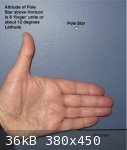
jdowning - 3-6-2011 at 01:11 PM
The Kamal or 'Guide'
According to researchers into early navigation techniques a Kamal consists of a 'sighting plate' - a small rectangle of wood or bone, measuring
"about 1 inch by 2 inches" with a string attached to its centre. The string is knotted at different points along its length.
The Kamal is used to determine latitude, the sighting plate taking the place of the fingers and a knot in the string held in the teeth until the
bottom of the plate appears to align with the horizon and the top of the plate with the Pole star. According to one researcher, the string on a Kamal
was calibrated so that the knots on the string were spaced at intervals equivalent to an 'isba' (the width of a finger or
1 degree 3 minutes angle of altitude) with markings from 1 to 16 'isba'.
There are a number of surviving examples of Kamel in museums.
The attached image is a replica that I made with knots spaced in 'isba' units (calculated using basic trigonometry). I was only able to tie 10 knots
on the string before the knot spacing became too small to be practical. Another limitation is that as the sighting plate is held closer to the eye of
the observer it becomes more difficult to focus clearly on the edges of the plate as well as the horizon and Pole star - especially for us older guys
with less than perfect vision.
The seafarers likely had a collection of Kamel - each dedicated to locating the latitude of a particular place - a knot tied in the string at the
correct position after taking a latitude reading before leaving the home port and on arrival at the required destination.
So what has this got to do with this investigation into the
14th C Ibn al-Tahhan oud?
Well, Farmer - as previously mentioned - mysteriously refers to the Arabic word 'aqd' as a unit of linear measure equal to the length (2.25 cm) that
he reckons is equivalent to a 'finger' unit (in this case an 'isba') - yet 'aqd' means 'knot'. Could it be, therefore, that Farmer is using his (or
the original scribe's) interpretation of 'aqd' based upon - perhaps - a now obsolete Arab nautical term where a 'knot' on a Kamel string means
1 'isba'? Now impossible to know for sure.
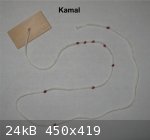

jdowning - 3-7-2011 at 11:46 AM
Interesting to note that the Romans considered an inch to be the width of a thumb whereas the rest of the ancient world used the width of a finger. A
Roman foot was equivalent to 29.6 cm (80:81 of an Egyptian foot of 30 cm) and it was divided into 12 'inches' equal to 2.46 cm.
So this presumably is the origin of ALAMI's thumb 'knot'.
However, I do not intuitively believe that 'aqd' in the Ibn al-Tahan manuscript refers to a linear measurement. After all why would the scribe when
recording measurements (albeit in error) in the standard units of 'isba', 'isba madmoum' and 'shibr' suddenly decide to introduce another, more
obscure, unit of measure? It just doesn't make sense.
Although the original manuscript copy would need to be re-examined to verify this - I suspect that 'aqd, used in this context, means the point at
which the neck joins with the bowl i.e. the neck joint - emphasising that the length of the finger board (1 'shibr' or 12 'isba') terminates at the
neck joint.
Let's see how this concept works in practice with the proposed corrected dimensions and geometry.
jdowning - 3-7-2011 at 12:21 PM
The Revised Ibn al-Tahhan Geometry
The attached image is the proposed geometry of the Ibn al-Tahan oud - drawn to scale in 'finger' units - according to the corrected dimensions
proposed by Curtis Bouterse and my proposed upper sound board profile, revised neck length. and assumed neck joint width of 2 'finger' units.
With the shorter neck length of 12 'finger' units (as opposed to 13 'finger' units given by Farmer) it can be seen that the neck length is then 1/3 of
the string length which is the classic proportion found on ouds to this day. The radius of the arc describing the upper sound board profile increases
from R = 29 'finger' units to R = 32 'finger' units. The significance of R = 32 'finger' units will become more apparent later.
It is useful, for purposes of comparison between oud/lute geometric profiles to express R in non dimensional (ND) units where the width of a sound
board is divided into 4 equal parts. In this case each part is 4 'finger' units and R becomes 32/4 or 8 in ND units.
Another point to note is that if Farmer's value of 'finger' unit, equal to 2.25 cm, is applied the string length becomes 81 cm. Ibn al-Tahhan mentions
that he no longer used frets on his oud which implies that a finger unit of 2.25 cm is incorrect the string length of 81 cm being practically
unmanageable for a fretless oud - or even for one that is fretted.
On the other hand using a 'finger' unit of value
1.875 cm gives a string length of 67.5 cm - another significant measurement as it turns out.
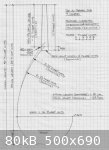
jdowning - 3-7-2011 at 12:46 PM
This last result is not to say that Farmer's 'finger' unit of 2.25 cm should be discounted in all cases.
Al-Kindi the 9th C philosopher gives the position of the plectrum guard (midrab al-adwar) on an oud as fixed at 3 'asabi' from the bridge which is
equal to a tenth of the string length. So the string length of an oud in Al-Kind's time was 30 'finger' units.
Applying a 'finger' unit of value 2.25 cm gives - lo and behold - a string length of 67.5 cm!
For comparison let's look next at the geometry of another 14th C - that described in the Kanz al-Tuhaf ( Casket or Treasury of Music Rarities)
ALAMI - 3-7-2011 at 01:02 PM
John, just a side note concerning the assumption that:
" the string length of 81 cm being practically unmanageable..."
Such a length is unmanageable for our modern playing techniques and compositions but is it so for ancient ways of playing oud
An old oudist told me that he went to Aleppo in the fifties to study with a well known master and that the master forced him to put horizontally a
pencil between his left hand fingers in a way so he can only use the first and third fingers to play, the second finger and the pinky being "disabled"
by being held behind the pencil, I am not sure if you can see what I mean, I don't have a camera to illustrate.
The point is that oud at the time was almost never used as a solo instrument, it was meant to accompany the singer, in fact Mawsili and Zeryab were
singers and composers and not just oudists like we may think today. Loudness and sustain may have been more important than playability in our modern
sense.
I don't know, it is just a thought. We know that the neck got shorter in the regions where instrumental and technically demanding music had its place:
first in Turkey, then in Iraq then with modern Arab oudists who start perform solo music.
jdowning - 3-8-2011 at 06:26 AM
This is, of course, an important observation Mahmoud. When using gut and silk strings - as were used exclusively on the oud from the 8th C (or before)
until at least the 18th C (I would guess), string length is of great importance. The longer the string length the easier it is to obtain a
satisfactory acoustic performance from the strings - particularly the thicker bass strings - although perhaps less of a problem for the early 4 course
ouds dating to the time of Mawsili and Ziryab (8th/9th C). According to Farmer the ouds of that time were also fretted so a string length of 81 cm
would have been valid for an instrument used for relatively slow vocal accompaniment.
The same parallel is found in the lute where the longest (fretted) string lengths were found on instruments like the archlute or chittarone used
mainly for voice or instrumental accompaniment (continuo playing). By the end of the 17th C and beyond, the French and German 'baroque' lutes had
fretted string length of around 69 to 73 cm - probably about the limit for a solo, fretted instrument. The bass strings (beyond the stopped 6th/7th
course strings) were longer but were only played 'open' like harp strings.
The shorter string length, wider bodied ouds seems to have made an appearance by the 14th C judging from the familiar engraving of an oud in 'Kitab
al-Adwar' (although it still has frets) that seems to match the geometry of the traditional Turkish oud quite well (so likely had a string length in
the range 54 cm to 58.5 cm ?)
My current thinking is that the longer string length, narrow bodied, fretted oud continued in use until the 16th C at which time some prominent German
luthiers - recognising a good thing when they heard it - used this design as the basis for their lutes, their reputation as outstanding luthiers of
their time extending beyond their lifetimes as a consequence. More on this later.

jdowning - 3-8-2011 at 11:49 AM
The dimensions of the oud described in the 14th C 'Kanz al-Tuhaf' - like the 'Ibn al-Tahhan' oud - appear to suffer from similar scribal error.
Curtis Bouterse has again proposed corrections to produce an instrument of more credible proportions. The attached image is drawn using the corrected
dimensions as well as my proposed upper sound board profile assuming a neck joint width of 2 'finger' units.
Note that the length of the neck is 1/4 of the overall length of the oud - a proportion found on ouds four centuries earlier. The width of this oud is
15 'finger' units (compared to 16 for the Ibn al-Tahhan oud) yet the value for R is the same equal to 32 'finger' units.
Out of curiosity I have superimposed a geometry assuming a neck length that is 1/3 string length and find that R becomes exactly 30 'finger' units
which when converted to a dimensionless number equals 8 (i.e. 30/15 x4 - as for the Ibn al-Tahhan oud with its equivalent neck proportion).
Again if Farmer's 'finger' unit of value 2.25 cm is applied, the string length is 67.5 cm. (or 56.25 cm if a 'finger' unit of
1.875 cm is used).
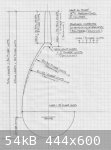
jdowning - 3-9-2011 at 01:05 PM
The study of historic Metrology is sometimes approached with ideas that are speculative and proposed solutions that are unproven so is considered by
the modern scientific community as a pseudoscience. These modern scientific materialists also apply the same category to Cosmology (the study of the
universe in its totality and humanity's place in it), Numerology (belief in a relationship between numbers and physical objects or living things),
belief in a Celestial Harmony or Harmony of the Spheres and Astrology (as it also relates to the movements of the planets). So most of the great
philosophers and scientists, past and present who have been engaged in these fields of study - the Ancient Egyptians and Greek philosophers such as
Plato and Ptolemy, Al-Kindi, the Ikhwan al-Safa, Kepler, Mersenne, and Newton - to name but a very few - must all be classed today as
'pseudoscientists'!
In the field of ancient metrology most scholars dismiss as unproven the conclusion of professor Livio Catullo Stecchini that all ancient measures are
by definition related - being derived by the ancients from their precise estimates of the circumference of the earth. Nevertheless it is of interest
to review what Stecchini has to say.
There were four fundamental types of ancient 'foot' linear measure - a foot consisting of 15 'fingers', one of 16 'fingers' (the basic foot), one of
17 'fingers' and another of 18 'fingers'. These were related by volume and weight so that, for example, an equal sided cubic measure with sides
measuring 16 'fingers' would weigh the same filled with water as one with sides measuring 17 'fingers' filled with wheat or one with sides measuring
18 'fingers' filled with barley. Stecchini designated these as a 'lesser foot' (15 'fingers'), a 'basic foot' (16 'fingers'), a 'wheat foot' (17
'fingers') and a 'barley foot' (18 'fingers'). The consistent value of a 'finger' - based upon the basic Egyptian foot of 30 cm - is 1.875 cm (16
'fingers' to a foot).
Stecchini then proposes a smaller 'trimmed' unit of value 1.85 cm based upon the Roman foot of 29.6 cm accounting for the difference between the
Egyptian and Roman foot - a ratio of 80:81 (or the 'discrepancy comma').
A cubit is a standard measure equal to 1.5 feet. so the common Egyptian cubit measured close to 45cm equal to 24 'fingers' ('finger' = 1.875 cm) and
the Royal cubit measured close to 52.5 cm equal to '28 fingers' ('finger' = 1.875 cm). As well there was a longer Persian royal cubit measuring 63.8
cm ('finger' = 2.28 cm).
Examples of Egyptian and Persian standard cubit measuring rods survive so it is possible to establish these values with some precision.
The Roman foot of 29.6 cm value was originally divided into 16 'fingers' ('finger = 1.850 cm). Then - just to further complicate matters - by the 5th
C the Roman foot was divided into 12 'uniciae' or 'inches'. The 'inch' was considered to be the width of a thumb (whereas the rest of the ancient
world preferred the width of a finger). So by the 5th C the Roman 'inch' in the Middle Eastern regions was equivalent to 2.47 cm.
An interesting twist to this is that if the Egyptian basic foot of 30 cm is divided by 12 (to convert it to 'inches') then an 'inch' becomes
equivalent to exactly 2.50 cm.
These are all 'finger' values that might be applied to the oud geometries so far proposed resulting in a variety of overall dimensions - dependent, in
each case, upon the chosen 'finger' unit.
So far the source of Farmer's 'finger' unit of 2.25 cm has yet to be found but maybe its origin is in the long Persian royal cubit - derived as an
approximation of the 2.28 cm 'finger' unit value perhaps?
jdowning - 3-30-2011 at 11:59 AM
A third early source giving the proportions of an oud is in the risalat al-musiqi of the Rasa'il - a monumental work written by the Ikhwan al-Safa.
The Ikhwan al-Safa (the Brethren of Purity) were a group of Muslim scholars located in Basra, Iraq during the
10th C. Their great contribution to humanity was in the writing of 52 volumes recording and saving for posterity all that they could of the scientific
and philosophic knowledge of the Greek and Roman civilisations.
Their description of the proportions of an oud - as translated by Dr Farmer - is as follows:
" ... the lute (al-ud) of wood (khashab), its length and its width, and its depth being in the most excellent proportions. These are that its length
should be half as much again as its width, and its depth should be half of it. And the neck ('unq) should be a quarter of the length."
This makes sense if the length of the bowl is 3/4 of the overall length of the oud with the neck being 1/4 of the overall length. The bowl is semi
circular in section with a radius equal to half the width of the sound board. Not much to go on!
However, if it is assumed that the lower part of the sound board is a semi circle of radius 8 units and the width of the neck joint is 2 units then
the arc of the upper part of the sound board is 22 units in radius. This gives a profile of credible proportions.
Note that the Kanz al-Tuhaf oud also has a neck length of 1/4 overall length but that it is proportionally more elongated than the Ikhwan al-Safa
oud.
The Ikhwan al-Safa were cosmologists and numerologists to a man - believing in one divinity and the place of the human being in the universal
harmony.
Their philosophy on the significance of numbers is of interest in trying to deduce a bit more about the possible geometry and dimensions of their
oud.
More to follow.
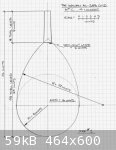
jdowning - 4-1-2011 at 12:31 PM
The Ikhwan al-Safa were numerologist - attributing significance to numbers as they relate to physical objects or living things.
For example, in writing about the oud, the number of strings (courses) is limited to four - "no more and no less so that their productions would be
comparable to natural things that are under the lunary sphere and in the image of the science of the Creator ..." and so relating to the four elements
Fire, Air, Water and Earth.
The string diameters relate in the proportion 4:3. Also the number of silk strands making up each string is 64 for the Bamm string, 48 Mathlath, 36
Mathna and 27 Zir.
Another example is that the equal sided cube is considered to be an eminent form having 6 square faces, 8 plane angles, 12 parallel intersections and
24 right angles. When applied to string lengths the numbers 24:12:8:6 give the first four tones of the harmonic series so are in harmonic proportion
to one another.
They go on to describe the virtue of the number 8 in the harmonious proportion believed to exist between the diameters of the celestial spheres
(planets) and those of the Earth and the Air (Earth = 8, Air = 9) resulting in the relative harmonic proportions 1:2, 3:2, 4:3 etc.
Note that a more detailed account is in "The Harmony of the Spheres - a sourcebook of the Pythagorean Tradition in Music" by Joscelyn Godwin. Godwin
here references a translation of 'The Epistle on the Music of the Ikhwan al-Safa' by Professor Amnon Shiloah, Tel-Aviv University, 1978.
Next to examine how the number 8 and these numerical proportions might be applied to deduce a possible development of the basic Ikhwan al-Safa oud
geometry.
jdowning - 4-1-2011 at 05:07 PM
The number 8 also has significance to the Ikhwan al-Safa as the primary dimensional form of a cube (2X2X2 = 8).
The attached image is a proposed developed geometry of the basic description of an oud by the Ikhwan al-Safa.
Assuming a maximum width of 16 units (8X2), the distance to the neck joint can be defined by a 3:4:5 'Pythagorean' triangle. If the neck length is
extended towards the bridge by one unit, the upper sound board profile may then be defined by an arc of radius equal to 20 units. Using the same 3:4:5
triangle relationship, the first possible bridge position is defined giving a string length of 27 units (the next cubic relationship 3X3X3 = 27).
The second bridge position possibility (#2) is with the bridge mid way between the widest point and bottom of the sound board. This geometry suggests
that of ALAMI's 19th C Al-Arja oud.
From this analysis my speculation is that the geometry of the oud described by the Ikhwan al-Safi, with a width of 16 units, had a bridge at position
#1, string length of 27 units and sound hole 4 units in diameter the top of the sound hole touching the radius R1 =8 units.
Is it now possible to guess the dimensions of this oud? Assuming a 'finger' unit of 1.85 cm or 1.875 cm gives an instrument of string length equal to
49.94 cm or 50.63 cm respectively - probably too short for an oud strung in silk.
Alternatively if the Roman 'thumb' ( or 'unica' or 'inch') measurement is used string length becomes 54 cm for a 2cm 'thumb' unit (still a bit short),
60.75 cm for a Farmer unit of 2.25 cm or 67.5 cm for a 2.5 cm unit with sound board widths equal to 32 cm, 36 cm and 40 cm respectively.
For bridge position #2 - string length equal to 28 units, the respective length are equal to 56 cm, 63 cm and 70 cm with sound board widths of 32 cm,
36 cm and 40 cm.
If I recall correctly, the string length of ALAMI's Al Arja oud is about 63 cm with a sound board width of about 35.5 cm - suggesting that Farmer's
'thumb' unit of 2.25 cm (based upon this analysis) may perhaps have some validity? On the other hand, I previously estimated that the original string
length of the Al Arja might have been about 63.5 cm (due to neck material lost in repairs). If the old Persian 'thumb' unit equal to 2.28 cm is used
this would give a string length of 63.8 cm and width of 36.5 cm.
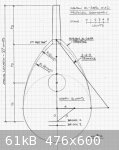
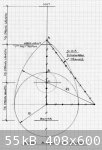
jdowning - 4-6-2011 at 05:09 AM
It is of interest to observe that the Ikhwan al- Safa were recording for posterity the characteristic features of the oud - an instrument of "the most
perfect of productions and most coordinated of constructions".
In defining an oud the Ikhwan al-Safa gave the number of strings (four courses - no more no less - and their material - silk not gut), the proportions
of their respective diameters, the number of frets, how they are tuned, their respective proportions, the number of notes produced by the strings
whether free or shortened and stopped and the relationship of these notes.
The also described the bowl of an oud as being made from thin boards of a light wood and with a sound board of a thin, hard, light wood such as will
resound when played.
So the oud proper (like the European lute and modern oud) was of 'built up' construction and not carved from a solid plank of wood with the bowl and
neck in one piece.
From this it might be possible to distinguish a true oud from an 'oud like' instrument in the early iconography by the presence of a distinct neck
joint rather than a neck than blends smoothly into the sound board profile (implying a one piece, carved construction).
